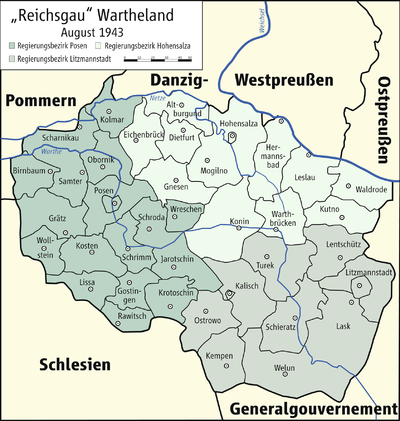Dietfurt district (Wartheland)

Dietfurt (Wartheland) district was the name of a German administrative unit in occupied Poland (1939–45) during World War II .
Prehistory (1815 to 1919)
The area around the western Polish city of Żnin belonged from 1815 to 1919 as the district of Znin to the Prussian province of Posen . In the course of the Wielkopolska Uprising , Żnin came under Polish control on January 18, 1919 and was officially ceded to the newly founded Poland on June 28, 1919 with the signing of the Treaty of Versailles .
Administrative history
At the beginning of the Second World War , German troops occupied the western Polish powiat Żnin , the district town Żnin was captured on September 9, 1939.
On October 26, 1939, the powiat under the name Dietfurt district (from May 21, 1941: Dietfurt district (Wartheland) ) was attached to the German Reich , which as a unilateral act of violence was ineffective under international law. The district became part of the administrative district Hohensalza in the Reichsgau Wartheland .
The district town Żnin ( Dietfurt ) became the seat of the German district office .
The German occupation ended with the invasion of the Red Army in January 1945.
politics
Land Commissioner
- 1939 : Heinz Müller-Hoppenworth (1907–1942)
District administrators
- 1939–1940: Heinz Müller-Hoppenworth ( substitute )
- 1940–1945: Herbert Banse
Municipal structure
The 119 localities of the district were initially grouped into 8 administrative districts . On January 1, 1942, the district of Żnin was named a city according to the German municipal code of 1935, on April 1, 1943, the district of Janowiec Wielkopolski. On January 1, 1942, two districts were merged. Towards the end of the occupation, the district consisted of two cities and 5 administrative districts.
size
The district of Dietfurt had an area of 741 km².
population
The Dietfurt district had in 1941: 42,022 mostly Polish inhabitants. Between December 1, 1939 and December 31, 1943, the German occupation authorities expelled over 5,500 Poles from the area.
A small German minority lived in the area, and Germans were also settled during the occupation. Towards the end of the occupation, most of them left the area.
The Jewish population was deported to the General Government and murdered there.
At the beginning of 1942, the RAD department K 4/36 was located there, which was deployed close to the front in the central section of the occupied territories of the Soviet Union the following summer.
Place names
The local occupation authorities immediately gave all localities in the district with German names, although officially, according to an unpublished decree of the Interior Minister of December 29, 1939, the German names valid in 1918 should initially continue to apply. On May 18, 1943, German names were set for all places with a post or train station in Wartheland , although there were again deviations.
List of cities and administrative districts in the Dietfurt district:
| Polish name | German name (1918) | German name (1939-1945) |
|---|---|---|
| Gąsawa | Gonsawa | Gerlingen |
| Janowiec Wielkopolski | Janowitz | Jannowitz |
| Rogowo | Rogowo |
1939–1943 Seebrück 1943–1945 Roggenau |
| Żarczyn | Sartschin | Sassenfeld |
| Żnin | Tin | Dietfurt |
An example of the renaming
Rome - Wittenberg and back - In 1894/95, a 32 km long stretch of the district's own narrow-gauge railway was opened from the district town of Znin in a south-westerly direction to Oschnau station ( Ośno ). At km 21.3 was the breakpoint for the town of Rome, which at that time had 155 inhabitants.
After the district fell to Poland in 1919, the village was named Rzym. During the occupation in World War II , this designation was abolished. However, the earlier name Rome was not used, which probably seemed too "Catholic" to the new rulers. It was “reformed” and the village was now called - like Lutherstadt - Wittenberg (Posen). This is what it says in Koch's station directory, 52nd edition, supplement 1940, page 51.
However, in the timetable of the Deutsche Reichsbahn for 1943, the Rosenberg station appears at this point and in the timetable from July 3, 1944 in table 130 × the "Dietfurt Railway" the former station name Rome (Wartheland) appears again.
Web links
- District Dietfurt (Wartheland) Administrative history and the district administrators on the website territorial.de (Rolf Jehke), as of August 19, 2013.